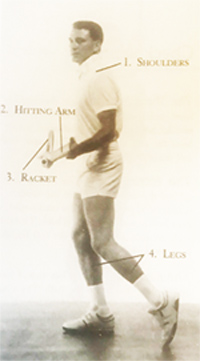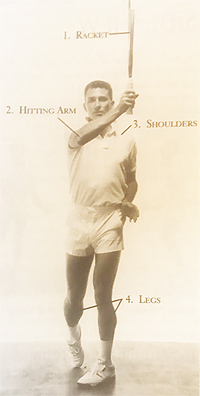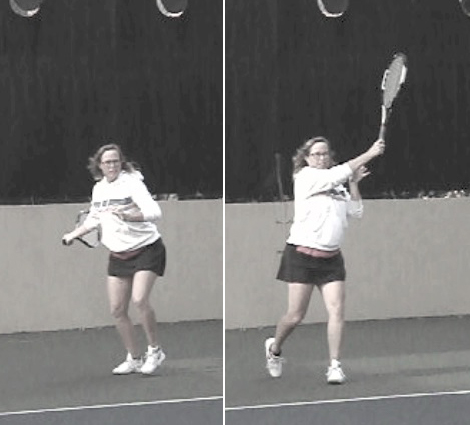Your Strokes:
Miller Forehand
John Yandell
This month we look at Miller's forehand. But this article is about more than helping her improve it technically. It's about how my own teaching has evolved over about 3 decades—basically a revisioning of the classical forehand model.
So how did we improve Miller's forehand and how did that relate to the evolution of my teaching model?
In the late 1980s, Miller played on championship teams I coached at University High School in San Francisco. Tennis wasn't her main sport. She was a varsity soccer player and a varsity swimmer.
But Miller was a good athlete and played enough tennis to make the number one doubles spot. With a couple of exceptions over the years, our teams never had highly ranked tournament players. Our strength was our depth—the lower 2 or 3 singles spots and especially our doubles.
Part of the reason for that strength is that almost all our players—even if they never played a tournament--trained with me in the off season and/or the summer at my tennis school—Miller included. She was a great, dedicated student!


30 Years Later
30 years after playing on the team, Miller and I reconnected to work on a project and she told me she had kept up with her tennis and was still playing regularly.
She also said wished her forehand was more of a weapon.
So when she came to my teaching court I was amazed to see her forehand was following the model I had used to teach her all those years ago—the model I documented in the first edition of my book Visual Tennis (Click Here.)
The stills show the body, arm and racket position at the key frames of the turn and the finish. Look at how my left arm stayed tucked on the turn with the shoulders turned about 90 degrees.
The finish was with the racket on edge, wrist at eye level, and the right hand about even with the left shoulder. Although I do believe in adding the wiper finish at some point, I think the vertical finish is still the place to start with lower level players with conservative grips. (For an article on the different finishes across the levels and grip styles, Click Here.)

And those positions from the book were virtually the same for Miller. Her left arm stayed in close to the body. Her shoulder turn was about 90 degrees.
She also had that perfect classical finish with the racket on edge. There was no need to change that.
The Revised Model
This was a model I had revised and improved substantially. In the new model, the body turn was much stronger. This had to do with what I had discovered about the role of the opposite arm. In 1997 we did the first high speed filming ever in live professional match play.
Reviewing the footage with several high level coaches we were all very surprised to see virtually every player stretched the left arm across the body on the turn so that it was basically parallel with the baseline and perpendicular with or pointing directly at the sideline.
This included the players with the two best forehands in the game at the time: Pete Sampras and Andre Agassi. None of us had ever seen this stressed in teaching, but there were all the top players in the world making that position of every forehand.
The effect of this stretch was another 20 degrees or more of shoulder turn in the preparation. The weight of the left arm coming across on the turn and then swinging back with the forward had to the adding to the speed of the torso rotation in the forward swing.
There wasn't any need to explain all that to Miller. But when we filmed her in high speed video it was amazing to see how closely her forehand followed the old model.
So what we did was have her model the full left arm stretch. Then I asked her to close her eyes and visualize the position. Then I asked her to use the image as a mental blueprint as she began hitting balls again.
The result was amazing. Miller really took to the increased turn. Her left arm stretched and her shoulders naturally turned more.
Within a few balls it was obvious how the velocity of the ball increased. It was making a different, louder, more powerful sound coming off the racket.
She was pleased and so was I. I have always said I would rather be accurate than consistent.
Do I wish I had known enough to incorporate this more powerful turn in Visual Tennis? Sure. But I felt I was literally seeing the value of the evolution of my work in real time.
Next Miller is coming back to work on her volley. Stay Tuned.




